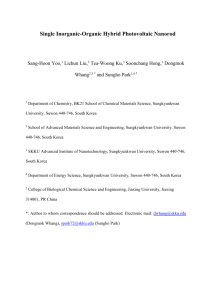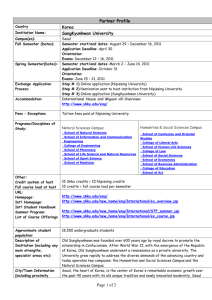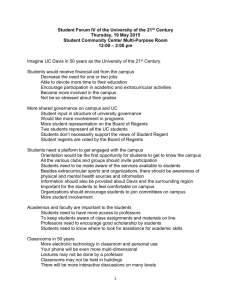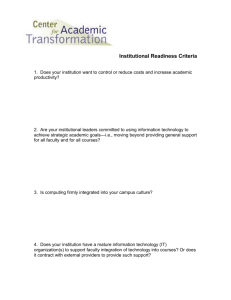SungKyunkuan University
advertisement
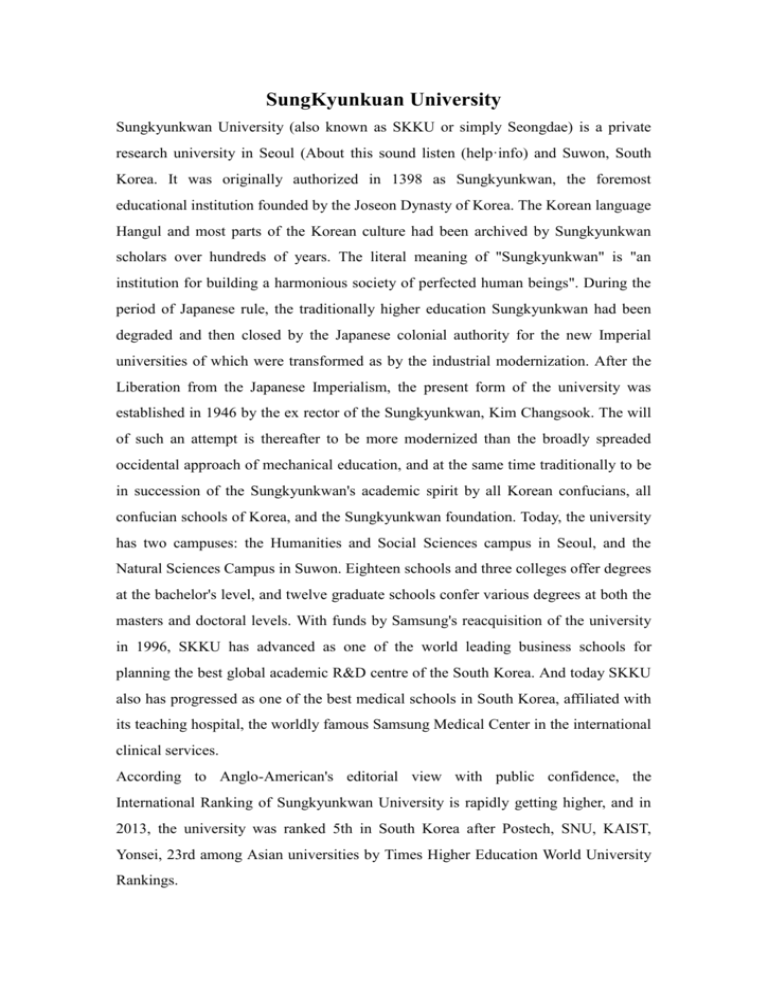
SungKyunkuan University Sungkyunkwan University (also known as SKKU or simply Seongdae) is a private research university in Seoul (About this sound listen (help·info) and Suwon, South Korea. It was originally authorized in 1398 as Sungkyunkwan, the foremost educational institution founded by the Joseon Dynasty of Korea. The Korean language Hangul and most parts of the Korean culture had been archived by Sungkyunkwan scholars over hundreds of years. The literal meaning of "Sungkyunkwan" is "an institution for building a harmonious society of perfected human beings". During the period of Japanese rule, the traditionally higher education Sungkyunkwan had been degraded and then closed by the Japanese colonial authority for the new Imperial universities of which were transformed as by the industrial modernization. After the Liberation from the Japanese Imperialism, the present form of the university was established in 1946 by the ex rector of the Sungkyunkwan, Kim Changsook. The will of such an attempt is thereafter to be more modernized than the broadly spreaded occidental approach of mechanical education, and at the same time traditionally to be in succession of the Sungkyunkwan's academic spirit by all Korean confucians, all confucian schools of Korea, and the Sungkyunkwan foundation. Today, the university has two campuses: the Humanities and Social Sciences campus in Seoul, and the Natural Sciences Campus in Suwon. Eighteen schools and three colleges offer degrees at the bachelor's level, and twelve graduate schools confer various degrees at both the masters and doctoral levels. With funds by Samsung's reacquisition of the university in 1996, SKKU has advanced as one of the world leading business schools for planning the best global academic R&D centre of the South Korea. And today SKKU also has progressed as one of the best medical schools in South Korea, affiliated with its teaching hospital, the worldly famous Samsung Medical Center in the international clinical services. According to Anglo-American's editorial view with public confidence, the International Ranking of Sungkyunkwan University is rapidly getting higher, and in 2013, the university was ranked 5th in South Korea after Postech, SNU, KAIST, Yonsei, 23rd among Asian universities by Times Higher Education World University Rankings. History Sungkyunkwan was established in 1398 to offer prayers and memorials to Confucius and his disciples, and to promote the study of the Confucian canon. It was located in the capital Hanseong, modern-day Seoul. It followed the example of the Goryeo-period Gukjagam, which in its later years was also known by the name "Sungkyunkwan". Sungkyunkwan was Korea's foremost institution of higher learning under the Joseon Dynasty education system. After the period of Japanese rule, with the emergence of the Republic of Korea, the old Sungkyunkwan was reincorporated as a private institution without the sanction of defunct Joseon Dynasty. As Korea modernized and underwent social and economic reforms, the university grew rapidly to keep up with the diverse demands of the advancing country. In 1946, the entering class numbered 155. The number of graduates now totals approximately 130,000. Sungkyunkwan now operates two campuses: the Humanities and Social Sciences Campus in Seoul and the Natural Sciences Campus in Suwon. Faculties and enrollment Data from April 2008 Full-Time Professors: 1,138 / Emeritus Professors: 137 / Research Professors: 201 / Clinical Professors: 63 / Associate Professors: 1,687 / Lecturers: 633 / Adjunct Professors: 290 / Visiting Professors: 104 / Exchange Professors: 2 / Others: 4 Total: 4,259 Data from March 2008 Enrollment of Undergraduate: 27,639 / Master Course: 5,980 / Doctor's Course: 1,210 / Unified Course: 215 Total: 35,044 Campus Humanities and Social Sciences Campus The deep roots of the university are so strongly entwined with Seoul that the university cannot be described in isolation from the city. Like the university, Seoul is the center of Korea's remarkable economic growth over the past 40 years with its unique tradition and current modernity. Seoul was the seat of government as early as the Baekje Kingdom for over 1,500 years. However, the city became more important with the establishment of the Joseon Dynasty in 1392, when it became the capital city. The university is located inside Seoul city walls, within the original capital of Joseon. Located uphill from the original Sungkyunkwan site, the Humanities and Social Sciences Campus is spread over a hill looking down on Jongmyo Royal Shrine, which has been designated by as a National Treasure. Just like Seoul, the university grew rapidly, and the expansion called for a new campus. The original site was preserved as the Humanities and Social Sciences Campus, while the expanding science programs were moved to a new campus in Suwon. Currently, 6 schools, 3 colleges and many graduate schools call the Humanities and Social Sciences Campus their home. To commemorate the founding philosophy of the university, the 600th Anniversary Memorial Hall, which houses the Academy of East Asian Studies, was constructed on this campus. This new facility has a floor space of 31,930 square meters as well as four underground levels and six above-ground storeys. Natural Sciences Campus The university's modern Natural Sciences Campus was established in 1978. This campus is situated 45 km away from the south of Seoul, on a 250-acre (1.0 km2) site. The campus is home to 5 schools, 2 colleges and various graduate schools. The management of the Natural Sciences Campus is considered a paragon of educational administration in Korea. When the new campus was built, the idea of an equal dual campus system was new to Korean higher education; this system remains unique in Korea. Some comprehensive universities located in large cities have tried to meet the need for expansion by founding separate, usually smaller campuses in rural areas. Besides solving the problem of physical expansion, the separate campus system brought the University many opportunities for growth. Suwon preserves the traditional beauty of the Joseon era (1392–1910), but it also now flourishes as a center for business, education and economic research, due to its proximity to major industrial complexes. In an effort to serve society by building a bridge between academia and the industrial sector, another initiative, the Science Technology Park (STP), is being developed at this campus. The university, industries in the surrounding area, and the government have combined forces in this project. Sungkyunkwan Advanced Institute of Nanotechnology SAINT is the abbreviation of Sungkyunkwan Advanced Institute of Nanotechnology. This institute opened on March, 2005. SAINT was founded on March 1, 2005 as one of the 4 core programs of Sungkyunkwan University’s VISION2010+ plan to be ranked in the top 100 universities in the world. With the financial support from Samsung Advanced Institute of Technology (SAIT), Its goal is to become one of the top 5 nanotechnology-related institutes by the year 2010, Dr. Sumio Iijima who discovered carbon nanotubes is the Dean of SAINT now. Sungkyun Language Institute Background Sungkyun Language Institute (SLI) is a semi-autonomous division of Sungkyunkwan University. English, Japanese, Mandarin and Korean are all taught, though Mandarin is not taught at the Suwon campus. Korean is taught at 6 levels from beginner to advanced levels. There are 18 lecturers of Korean and 16 foreign lecturers of English at the campus in Seoul, with 14 foreign English lecturers in Suwon, while the 2 Japanese lecturers based in Suwon are themselves Korean. There are also several foreign lecturers of other languages in Seoul and Korean lecturers of English on both campuses. SLI is managed separately from the university and the management follows different systems of organisation on the two campuses, yet they both fall under an umbrella level of administrative management. Courses Both credit and non-credit classes are taught. The English credit courses are chiefly in Academic Writing and Academic Presentations, though there are also ESP (English for Specific Purposes) classes in Business English, English for Scientific Purposes, English Literature and Current English at the Suwon campus. Non-credit classes are less specialised, and are therefore more typical of ESL environments. These are also open to people who are not registered as students at Sungkyunkwan University to attend. It is not uncommon for members of staff or local residents to attend such classes. For the main courses (Academic Writing and Presentations), SLI produces its own books, which are published by Sungkyunkwan University Press and which have thus far been revised on a yearly basis. Facilities SLI has a "Global Zone" – a room in which students may relax, study, read, browse the web, view online lectures, attend conferences, watch international TV, or seek English assistance from the lecturers – on each site. These are relatively recent additions, that in Seoul having been added in 2004 and that in Suwon in 2005.
